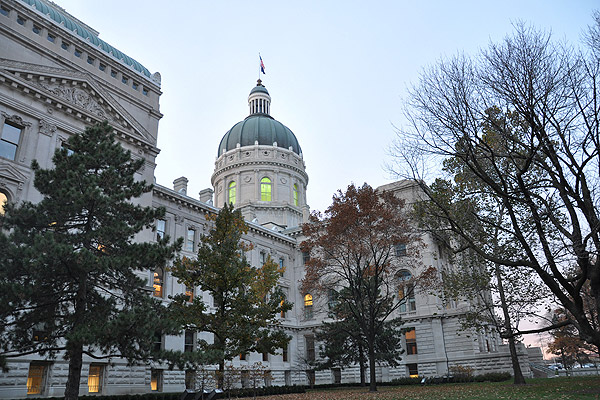
This morning, when I was dimly awake, I thought I heard something in a Morning Edition intro to Niala Boodhoo's "Changing Gears" story about Wisconsin, mentioning that, as previously described on NPR's site, Indiana is the Rust Belt's first right-to-work state. In the haze of undersleeping, I thought hang on, that's not quite the case. Indiana is the only right-to-work state in the Rust Belt, and it is the first one… but it's been a right-to-work state before.
In 1955, 1,200 members of the UAW marched on the Perfect Circle piston ring foundry in New Castle, Indiana. Company snipers and union snipers exchanged fire, wounding seven—the "kind of bloody labor battle whose ugly look the U.S. had almost forgotten." The Tribune's editorial called it "Indiana in Disgrace":
What is of first importance is this chain of events: The union called a strike at the plant; nevertheless, some employees did not quit their jobs; disorders followed; strikers who engaged in vilence were informed that they would not get their jobs back when the strike was ended; in retaliation, the union summoned members from near and far to march on the plant, surround it, terrorize the men and women at work, and so close the place down.
It was even more tense than that: lieutenant governor Harold Handley sent 200 state troopers to enforce a cease-fire, and his ideological foe, governor George Craig, sent in the National Guard, with World War II tanks. Tension had been building for years:
Driven by their desire to hold down labor costs and their own antistatist ideology, Perfect Circle’s owners had opposed the New Deal and, by the late 1930s, had shed their previous provincialism to join the national political coalition of business conservatives in the National Association of Manufacturers to secure the passage of the Taft-Hartley Act in 1947…. As with many business conservatives, Perfect Circle owners tried to rid their plants of unions by tapping into an interlocking network of well-financed right-wing policy groups to mount an extensive employee educational program and public relations campaign in defense of "free enterprise"…. The strike became a conservative cause celebre during the 1957 national “right-to-work” campaign and a centerpiece of the Senate’s 1958 McClellan “Labor Rackets” hearings, which launched Barry Goldwater’s bid for the 1964 presidency.
The next year, Handley defeated his Democratic opponent, giving Indiana a Republican governor and Republican majorities in both houses, much like Indiana has right now. In February of 1957, the Tribune reported that labor violence broke out again, this time in Princeton over the electrical-relay maker Potter & Brumfield: "The plant president deplored the strike spawned 'rule by the gun' and likened it to communism." Troopers were called out again.
Less than three weeks later, the Republican-dominated general assembly passed a right-to-work bill, and "its backers called it a long overdue declaration of independence for the working man." The next day, 10,000 people protested at the Indiana capitol; 7,500 of them actually got in the building, as the governor, who let the bill pass without his signature and called it "the responsibility of the legislature," slipped out the back door.
By 1958, the right-to-work law was the central issue in Indiana politics, as Joseph Ator reported in a news analysis:
Keystone of the governor's campaign is Indiana's right-to-work law. The record on this measure is a trifle confused. After he took office he announced that he would not sign the measure, should the legislature pass it, but that he would not veto it. It became law without his signature.
Leaders of former AFL unions, which supported Handley's candidacy, consider that they had his promise to veto any right-to-work bill, and have denounced him as a turncoat.
Be that as it may, the governor now says that while he was dubious of the merits of the right-to-work law when it was proposed, his study of its operation has convinced him of its value, and he is prepared to resist to the death the efforts of Reuther and the CIO to get it repealed.
[snip]
But not all industrial employees in the state are urban residents. An increasing proportion of them, until the recession cost their jobs, are farmers or residents of farm communities, who commute to the factories. They have been less thoroly indoctrinated by the CIO that "right-to-work" is an invention of the devil.
Some of the rhetoric about Indiana versus the rest of the Midwest… well, it should sound familiar:
Indiana is a debt-free state whose largest source of operating income is a gross reciepts tax—in effect a flat rate income tax—which bears as heavily on labor as corporations.
Its favorable tax climate has undoubtedly been a major attraction to industries that are opening new plants in the state at the rate of ten a month. A substantial proportion of these are automobile and automotive supply companies, or branches of such companies, which are increasingly concerned with the punitive taxes that have accompanied the rule of Michigan's Gov. G. Mennen [Soapy] Williams.
Indiana remained a right-to-work state for another seven years. Lyndon Johnson's landslide victory over Barry Goldwater—he won Indiana, the first Democrat in 28 years to do so—brought in Democratic majorities in both houses of the General Assembly. It also gave Indiana a Democratic governor, although he essentially won by going to the right of his tax-hiking Republican opponent. Despite his conservatism, Roger Branigin signed the right-to-work repeal, and Indiana rejoined its Rust Belt peers.
So Indiana's passage of a right-to-work law isn't so much something new as a return to the past. As Rick Perlstein ably points out in Before the Storm, Indiana isn't just historically a GOP stronghold, it's also in some respects the birthplace of contemporary conservatism, at least the vein that runs through Goldwater through the Tea Party. As in the 1950s, that tradition has swelled. Its neighbors bear watching, as does the traction of its traditional conservative ideology.
Photograph: vxla (CC by 2.0)


